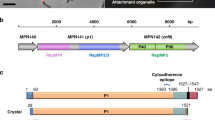Abstract
Thirty-seven clinical isolates ofMycoplasma pneumoniae, cultured from patients' respiratory material between 1986 and 1994, were typed by immunological methods and by polymerase chain reaction (PCR). For immunological typing two monoclonal antibodies (mAb) were used that recognized the P1 adhesion ofMycoplasma pneumoniae strain FH but differed in their ability to inhibit the adherence ofMycoplasma pneumoniae to erythrocytes. The mAb P1.58, which was not able to inhibit adherence, showed reactions with all patients' isolates in immunoblots, whereas the adherence-inhibiting mAb P1.62 reacted with only seven patients' isolates. Due to variations within the P1adhesin genome ofMycoplasma pneumoniae group 1 (Mycoplasma pneumoniae type strain M129) and group 2 (Mycoplasma pneumoniae type strain FH), two primer sets were designed. According to the size of the PCR-amplification products, all clinical isolates that showed no mAb P1.62 reactivity belonged toMycoplasma pneumoniae group 1, whereas mAb P1.62-positive-reacting mycoplasma isolates were characterized as group 2 strains. During an outbreak ofMycoplasma pneumoniae diseases in 1992, all 19 clinical isolates showed no cross-reactivity in immunoblots with the mAb P1.62 and were typed by PCR asMycoplasma pneumoniae group 1 strains. Furthermore, 206Mycoplasma pneumoniae complement fixation test — positive patient sera (titer>1∶40) from the study period were tested for adherence-inhibiting antibodies towards both type strains. Thirty-two sera showed adherence-inhibiting antibodies towards group 1 and 22 towards group 2 mycoplasmas. In only seven sera were adherence-inhibiting antibodies directed to bothMycoplasma pneumoniae groups. The serological data of the outbreak in 1992 revealed that patients withMycoplasma pneumoniae group 1 infections developed adherence-inhibiting antibodies more frequently than did patients infected with group 2, which might have implications for the pathogenesis ofMycoplasma pneumoniae diseases and subsequent infections.
Similar content being viewed by others
References
Jacobs E:Mycoplasma pneumoniae virulence factors and the immune response. Review of Medical Microbiology 1991, 2: 83–90.
Razin S, Jacobs E: Mycoplasma adhesion. Journal of General Microbiology 1992, 138: 407–422.
Jacobs E, Buchholz A, Kleinmann B, Bredt W: Use of the adherence protein ofMycoplasma pneumoniae as antigen for enzyme-linked immunosorbent assay (ELISA). Israel Journal of Medical Sciences 1987, 23: 709–712.
Gnarpe J, Lundbäck A, Sundelöf B, Gnarpe H: Prevalence ofMycoplasma pneumoniae in subjectively healthy individuals. Scandinavian Journal of Infectious Diseases 1992, 24: 161–164.
Jacobs E, Stuhlert A, Drews M, Pumpe K, Schaefer HE, Kist M, Bredt W: Host reactions toMycoplasma pneumoniae infections in guinea pigs preimmunized systemically with the adhesin of this pathogen. Microbial Pathogenesis 1988, 5: 3032–3029.
Gerstenecker B, Jacobs E: Topological mapping of the P1-adhesin ofMycoplasma pneumoniae with adherence-inhibiting monoclonal antibodies. Journal of General Microbiology 1990, 136: 471–476.
Jacobs E, Pilatschek A, Gerstenecker B, Oberle K, Bredt W: Immunodominant epitopes of the adhesin ofMycoplasma pneumoniae. Journal of Clinical Microbiology 1990, 28: 1194–1197.
Jacobs E, Schöpperle K, Bredt W: Adherence inhibition assay: a specific serological test for detection of antibodies toMycoplasma pneumoniae. European Journal of Clinical Microbiology 1985, 4: 113–118.
Foy HM, Kenny GE, Cooney MK, Allan ID: Long-term epidemiology of infections withMycoplasma pneumoniae. Journal of Infectious Diseases 1979, 139: 681–687.
Marrie TJ: Community-acquired pneumonia. Clinical Infectious Diseases 1994, 18: 501–515.
Su CJ, Chavoya A, Dallo SF, Baseman JB: Sequence divergency of the cytadhesin gene ofMycoplasma pneumoniae. Infection and Immunity 1990, 58: 2669–2674.
Hayflick L: Tissue cultures and mycoplasmas. Texas Reports on Biology and Medicine 1965, 23: 285–303.
Jacobs E, Bennewitz A, Bredt W: Reaction pattern of human anti-Mycoplasmapneumoniae antibodies in enzyme-linked immunosorbent assay and immunoblotting. Journal of Clinical Microbiology 1986, 23: 517–522.
Sever JL: Application of a microtechnique to viral seralogical investigations. Journal of Immunology 1962, 88: 320–329.
Su CJ, Dallo SF, Baseman B: Molecular distinctions among clinical isolates ofMycoplasma pneumoniae. Journal of Clinical Microbiology 1990, 28: 1538–1540.
Kleemola M, Räty R, Karjalainen J, Schuy W, Gerstenekker B, Jacobs E: Evaluation of an antigen-capture enzyme immunoassay for rapid diagnosis ofMycoplasma pneumoniae infection. European Journal of Clinical Microbiology & Infectious Diseases 1993, 12: 872–875.
Lüneberg E, Jensen JS, Frosch M: Detection ofMycoplasma pneumoniae by polymerase chain reaction and nonradioactive hybridization in microtiter plates. Journal of Clinical Microbiology 1993, 31: 1088–1094.
Bernet C, Garret M, de Barbeyrac B, Bebear C, Bonnet J: Detection ofMycoplasma pneumoniae by using the polymerase chain reaction. Journal of Clinical Microbiology 1989, 27: 2492–2496.
Van Kuppeveld FJ, Johansson KE, Galama JM, Kissing J, Bölske G, Hjelm E, van der Logt JT, Melchers WJ: 16S rRNA based polymerase chain reaction compared with culture and serological methods for diagnosis ofMycoplasma pneumoniae infection. European Journal of Clinical Microbiology & Infectious Diseases 1994, 13: 401–405.
Ursi D, Ieven M, Van Bever H, Quint W, Niesters HGM, Goossens H: Typing ofMycoplasma pneumoniae by PCR-mediated DNA fingerprinting. Journal of Clinical Microbiology 1994, 32: 2873–2875.
Lind K, Hoier-Madson M, Wiik A, Clyde WA: Antibodies to the mitotic spindle apparatus in patients withMycoplasma pneumoniae infection. Immunology & Infectious Diseases 1992, 2: 249–255.
Author information
Authors and Affiliations
Rights and permissions
About this article
Cite this article
Jacobs, E., Vonski, M., Oberle, K. et al. Are outbreaks and sporadic respiratory infections byMycoplasma pneumoniae due to two distinct subtypes?. Eur. J. Clin. Microbiol. Infect. Dis. 15, 38–44 (1996). https://doi.org/10.1007/BF01586183
Issue Date:
DOI: https://doi.org/10.1007/BF01586183




